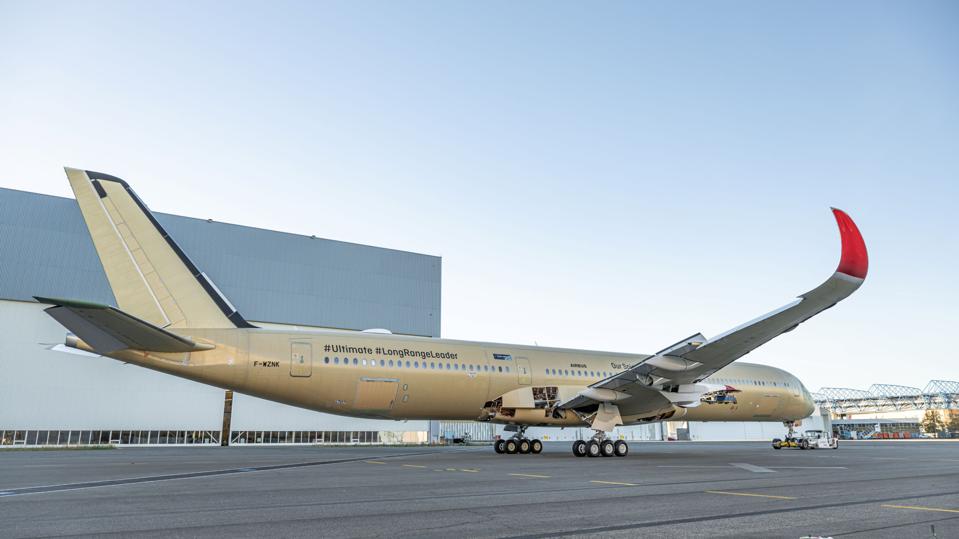Toulouse, France is a long way from Australia. But it is a journey that Qantas executives, engineers and pilots will be increasingly making. They’ll be going to check in on their newest baby, the Airbus A350-1000 designated as the airline’s first super-long-range Project Sunrise aircraft. The plane is designed for 20-hour flights from Australia to New York or London.
With a 22-hour range, the new plane will be able to fly the longest non-stop flights in the world, a record currently held by Singapore Airlines 19-hour nonstop from Singapore to New York. The world’s longest direct (but not non-stop) flight is the 29-hour Shanghai-to-Buenos Aires marathon operated by China Eastern.
According to Qantas, The Project Sunrise name is a nod to the airline’s historic ‘Double Sunrise’ endurance flights during World War II. These flights from Perth to Ceylon (today Sri Lanka) were, made from 1943 to 1945 using PBY Catalina flying boats. The aircraft remained airborne long enough for passengers to see two sunrises. The marathon flights, which could take anywhere from 27 to 30 hours or more depending on headwinds, covered almost 4000 miles at 125 miles per hour.
The current Airbus A350-1000, by contrast, has a cruising speed of 562 miles per hour. The new A350-1000ULR variant for Qantas, which Airbus is now building on its assembly line in Toulouse, is said to be capable of up to 22 hours of flight. The new variants will achieve “Ultra Long Range” with an additional 20,000 liter rear center fuel tank and enhanced systems.
But it’s not all about increased fuel capacity (hence fewer seats) and lower fuel burn. Qantas has been developing the latest “human tech” on board to help passengers stay healthy on the long flight. Or as the airline puts it, “every element is designed around passenger comfort and wellbeing for ultra-long-haul operations.”
The aircraft cabins have been developed from the ground up in collaboration with aviation specialists, Australian industrial designer David Caon, and a multidisciplinary team of experts from the University of Sydney’s Charles Perkins Centre. The team includes sleep scientists working to combat jetlag through features like customized lighting designs and timed meal service.
Key to the cabin design has been giving passengers more space. The ULR version has a 238-seat configuration versus the 300-plus seat layout used by other airlines operating the Airbus A350-1000. The additional space includes a purpose-built Wellbeing Zone located between the Premium Economy and Economy cabins. The Wellbeing Zone will offer integrated stretch handles, guided on-screen exercise programs, a hydration station and refreshments for passengers to snack on.
The research, the new lighting design and the additional space and well-being features will all be welcomed by passengers contemplating spending a day on a plane. The crew, particularly the flight attendants, will also be important in supporting the passengers through the long journey.
Based on my recent experience flying Qantas from Los Angeles to Brisbane and back, a mere 13.5 hours each way, I would say the airline’s personnel will excel at providing a day’s worth of passenger service.
The airline has been working with aircraft manufacturers since 2017 on Project Sunrise. The goal has remained constant: to connect Australia with the world, specifically the great cities of Great Britain and the United States. The Project Sunrise non-stop flights to New York and London from Australia’s East Coast (including Sydney, Brisbane, and Melbourne) will each cover about 11,000 miles.
The upcoming direct flights to London and New York will each take approximately twenty hours. But the non-stop journey will trim four hours or more off total travel time, compared with the one-stop flights available today.
Qantas has been keeping a close eye on the manufacturing progress made so far to this key addition to their fleet. According to the airline, airframe components including the forward, center and rear fuselage sections have all come together. The wings, tail section and landing gear are also now attached.
By mid-November the aircraft will be transferred to a new hangar where it will have engines and flight test instruments installed, in preparation for an extensive test flight program, commencing in 2026. The first passenger flights are projected for the first half of 2027, ten years after Project Sunrise began.
The A350-1000ULR underway at the Airbus Toulouse factory is scheduled for delivery in late 2026. It is the first of 12 similar planes ordered by Qantas to literally span the world.
“Given Australia’s position in the world, Qantas has a long history of breaking aviation barriers. Project Sunrise will not only overcome the tyranny of distance, it will fundamentally change the way our customers travel the world,” said Qantas Group Chief Executive Officer Vanessa Hudson. “These flights will cut up to four hours off the journey and transform how people experience ultra long-haul travel, through science-backed design to minimize jetlag and maximize wellbeing.”

